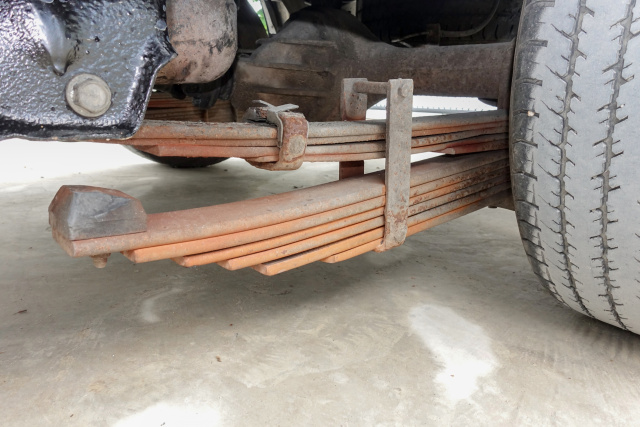Flat springs
Contents |
Introduction
Flat springs are flat strips of material which, when deflected by an external load, store and release energy. These types of spring are small, stamped metal components that function like a spring by controlling deflection within small or restricted spaces.
Manufactured from high carbon spring steel, nickel-silver, high nickel alloys and stainless steel, a flat spring can function as a spacer or ground.
Applications
Flat springs come in a range of different shapes and sizes for various applications. They are used for numerous purposes within differing industries, such as motors, office equipment, generators, counterbalances, doors and electrical switchgear.
There are many different types of flat spring including the leaf spring and flat coil spring.
Leaf Spring
Leaf springs are one of the oldest forms of spring, dating back to medieval times, they are an important component in suspension, such as in cars or other vehicles. They provide stability and help minimise wear and tear on other parts.
Created with individual layers or leaves of metal, they are often used in automotive design on drive or steer axles. Constructed of high alloy spring steel or lighter weight materials such as low carbon steel, this type of spring comes in three basic types; mono-leaf springs, multi-leaf springs and parabolic springs.
Mono-Leaf Spring
A mono-leaf spring consists of one plate of springs which is thick in the centre and tapers out to the ends. The amount and length of the taper is critical to the durability and safety of the spring. This type of spring provides lesser spring rates that can hold up a vehicle, also offering less stiffness in terms of bending and controlling the axle.
Multi-Leaf Spring
A multi-leaf spring is an engineered system designed to provide support, stability and safety to a vehicle. The length and make-up of each spring is important as each leaf is designed to carry a proportionate amount of load and stress. Each leaf is designed to provide support to the leaf above and below it, and it is this feature which provides support for the vehicle.
Parabolic Spring
A parabolic spring is a leaf or set of leaves which are tapered in a parabolic form rather than in a linear one. The tapering in a single leaf handles the force distribution from the vehicle to the axle, and works as a complete multi-leaf spring. Parabolic springs design is characterised by fewer leaves the thickness of which varies from the centre to ends following a parabolic curve, preventing unwanted inter-leaf friction. They tend to have more flexibility and are commonly used on buses.
Flat Coil Springs
Flat coil springs are used with a counterweight to control the action of valves, such as those in a vehicle exhaust system. They are wound into a specific configuration to absorb shocks or provide tension, and can be found in seating to provide support, or in automotive applications.
--European Springs and Pressings Ltd 12:46, 15 Nov 2017 (BST)
Related articles on Designing Buildings Wiki
- Compression springs.
- Key qualities of springs.
- Mechanical engineer.
- Spring materials.
- Tension springs v torsion springs.
- Torsion springs and their benefits.
- Using springs in construction to prevent disaster.
- Spotlight On: Flat Springs
- Spotlight on Compression Springs
- The Difference Between Tension and Torsion Springs
- The Importance of Gas Springs
- The Multiple Uses of Compression Springs
- The Uses of Wire Forms Within the Construction Industry
- Types of spring.
Featured articles and news
RTPI leader to become new CIOB Chief Executive Officer
Dr Victoria Hills MRTPI, FICE to take over after Caroline Gumble’s departure.
Social and affordable housing, a long term plan for delivery
The “Delivering a Decade of Renewal for Social and Affordable Housing” strategy sets out future path.
A change to adoptive architecture
Effects of global weather warming on architectural detailing, material choice and human interaction.
The proposed publicly owned and backed subsidiary of Homes England, to facilitate new homes.
How big is the problem and what can we do to mitigate the effects?
Overheating guidance and tools for building designers
A number of cool guides to help with the heat.
The UK's Modern Industrial Strategy: A 10 year plan
Previous consultation criticism, current key elements and general support with some persisting reservations.
Building Safety Regulator reforms
New roles, new staff and a new fast track service pave the way for a single construction regulator.
Architectural Technologist CPDs and Communications
CIAT CPD… and how you can do it!
Cooling centres and cool spaces
Managing extreme heat in cities by directing the public to places for heat stress relief and water sources.
Winter gardens: A brief history and warm variations
Extending the season with glass in different forms and terms.
Restoring Great Yarmouth's Winter Gardens
Transforming one of the least sustainable constructions imaginable.
Construction Skills Mission Board launch sector drive
Newly formed government and industry collaboration set strategy for recruiting an additional 100,000 construction workers a year.
New Architects Code comes into effect in September 2025
ARB Architects Code of Conduct and Practice available with ongoing consultation regarding guidance.
Welsh Skills Body (Medr) launches ambitious plan
The new skills body brings together funding and regulation of tertiary education and research for the devolved nation.
Paul Gandy FCIOB announced as next CIOB President
Former Tilbury Douglas CEO takes helm.
UK Infrastructure: A 10 Year Strategy. In brief with reactions
With the National Infrastructure and Service Transformation Authority (NISTA).
























